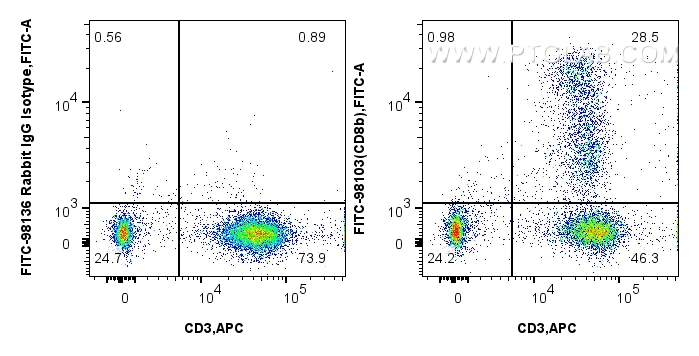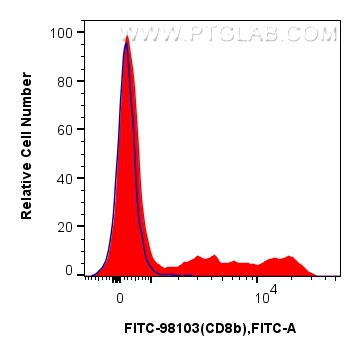验证数据展示
经过测试的应用
| Positive FC detected in | human PBMCs |
推荐稀释比
| 应用 | 推荐稀释比 |
|---|---|
| Flow Cytometry (FC) | FC : 5 ul per 10^6 cells in 100 μl suspension |
| This reagent has been pre-titrated and tested for flow cytometric analysis. The suggested use of this reagent is 5 ul per 10^6 cells in a 100 µl suspension or 5 ul per 100 µl of whole blood. | |
| Sample-dependent, Check data in validation data gallery. | |
产品信息
FITC-98103 targets CD8b in FC applications and shows reactivity with human samples.
| 经测试应用 | FC Application Description |
| 经测试反应性 | human |
| 免疫原 |
Recombinant Protein 种属同源性预测 |
| 宿主/亚型 | Rabbit / IgG |
| 抗体类别 | Recombinant |
| 产品类型 | Antibody |
| 全称 | CD8b molecule |
| 别名 | CD8, 241326A7, CD8b molecule, CD8B1, Leu2 |
| 计算分子量 | 243 aa, 27 kDa |
| GenBank蛋白编号 | BC100913 |
| 基因名称 | CD8B |
| Gene ID (NCBI) | 926 |
| 偶联类型 | FITC Plus Fluorescent Dye |
| 最大激发/发射波长 | 495 nm / 524 nm |
| 形式 | Liquid |
| 纯化方式 | Protein A purification |
| UNIPROT ID | P10966 |
| 储存缓冲液 | PBS with 0.09% sodium azide and 0.5% BSA, pH 7.3. |
| 储存条件 | Store at 2-8°C. Avoid exposure to light. Stable for one year after shipment. |
背景介绍
CD8b (T-cell surface glycoprotein CD8 beta chain) is an integral membrane glycoprotein that forms disulfide-linked heterodimers with CD8a (CD8 alpha chain). The CD8 alpha/beta heterodimer is the predominant CD8 complex expressed on the cell surface (PMID: 1534146; 2111591). CD8 is a transmembrane glycoprotein predominantly expressed on the surface of cytotoxic T cells and can also be found on natural killer cells, cortical thymocytes, and dendritic cells. CD8 serves as a co-receptor for the T cell receptor (TCR). Both CD8 and TCR recognize antigens displayed by an antigen presenting cell (APC) in the context of class I MHC molecules. CD8 plays a role in T cell development and activation of mature T cells.
实验方案
| Product Specific Protocols | |
|---|---|
| FC protocol for FITC Plus CD8b antibody FITC-98103 | Download protocol |
| Standard Protocols | |
|---|---|
| Click here to view our Standard Protocols |



